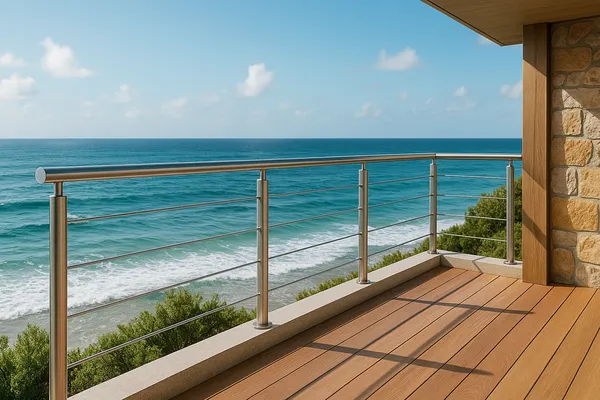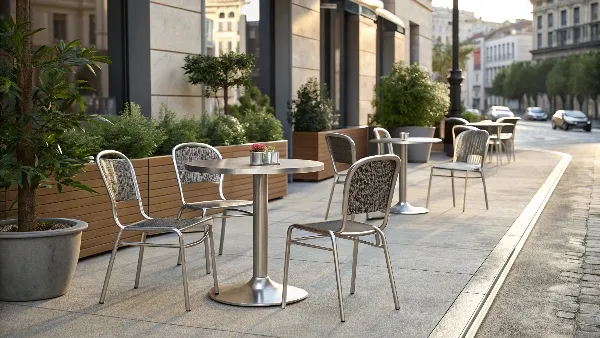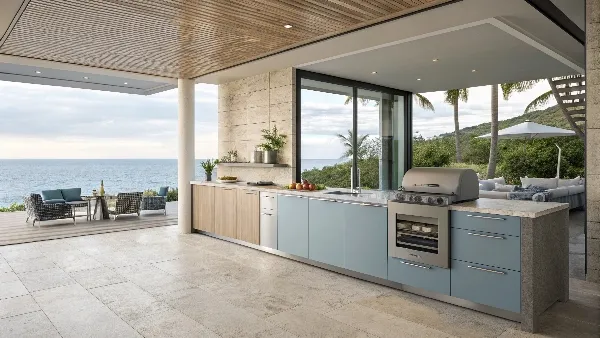Coastal air, acid rain, and snowmelt salts quietly eat away at regular steel. Left unchecked, rust ruins costly projects and reputations. 316 marine grade stainless steel stops that silent damage so your outdoor work lasts longer and looks premium.
Yes. Thanks to added molybdenum and extra nickel, 316 marine‑grade stainless steel delivers superior corrosion resistance in harsh, chloride‑rich outdoor and marine environments, outperforming Acciaio inox 304 and most other stainless steels while retaining high strength and easy fabrication.

1.What Makes 316 Stainless Steel “Marine Grade”?
2.How Does 316 Compare to 304 Stainless Steel Outdoors?
3.Why Do Chlorides Attack Some Stainless Steels Faster?
4.Is 316 Stainless Steel Worth the Extra Investment?
5.Key Differences Between 304 and 316 for Outdoor Furniture
6.Best Practices to Prevent Rust on Exposed Stainless Steel
7.Choosing the Right Stainless Steel for Outdoor Kitchens
8.Can Powder‑Coating Boost Durability Even Further?
9.Typical Outdoor Applications That Demand 316L Alloy
10.How to Source Consistent, Factory‑Priced 316 Marine Grade Steel from China
Acciaio inox 316 belongs to the austenitic family of stainless steels enriched with 16–18 % cromo, 10–14 % nichel, and—critically—2–3 % molibdeno. This extra molybdenum forms a stable oxide film that blocks chloride ions, giving the alloy outstanding resistenza alla corrosione in salty spray, pool chemicals, or acidic rain. Engineers often call it marine stainless steel because it survives coastal areas and shipboard duty where common grades of stainless steel fail.
Fatto: In ASTM salt‑spray tests, 316 lasts 5–10 times longer di 304 before showing pitting.
| Grade of Stainless Steel | Molibdeno (%) | Typical Chloride Threshold Before Pitting (ppm) |
|---|---|---|
| 304 | 0 | 200–250 |
| 316 | 2.0–3.0 | 500–1000 |
| Duplex 2205 | 3.0 | 1000+ |
When you place Acciaio inox 304 handrails near an ocean pier, tiny pits emerge in months. Switch to 316 and the polished surface stays bright for years. The key differences between 304 e 316 lie in that molybdenum boost:
| Proprietà | 304 | 316 |
|---|---|---|
| Pitting Resistance Equivalent Number (PREN) | 18–19 | 23–25 |
| Tensile Strength (MPa) | 515 | 515 |
| Magnetico? | Essentially non‑magnetic | Non‑magnetic |
| Typical Outdoor Lifespan (Urban) | 15–20 yrs | 25–30 yrs |
| Typical Outdoor Lifespan (Coastal) | 5–7 yrs | 15–20 yrs |
Need both alloys in one project? Our mill supplies Acciaio inox 304 e 316 sheets side‑by‑side, laser‑cut and batch‑number tracked for hassle‑free inspection—see our precision sheet service.
Chloride ions wedge under the passive chromium‑oxide skin, breaking it apart molecule by molecule. Molibdeno in Acciaio inox 316 ties up these ions, blocking pit formation. In contrast, 304 (a very common type of stainless steel) has no molybdenum; pits grow, deepen, and become rust pockets.
In coastal areas, airborne salt levels can exceed 650 mg/m²/day —well above 304’s safe limit.
In pool enclosures, sodium hypochlorite plus warm humidity speeds corrosion.
Engineers call this “pitting and crevice corrosion,” the silent killer of outdoor bollards, balcony screws, and decorative panels. Choosing marine grade steel early prevents costly retrofits.
Rule of Thumb: If a project lies within 15 km of the sea or uses de‑icing salts, the extra investment in 316 stainless steel pays back in under three years.
Case Study • Shanghai Riverside Walkway
Contractors first tried 304 balustrades. After two winters, brown tea‑stain streaks appeared. Switching to 316 marine‑grade stainless steel ended the rust issues—saving ¥180,000 in repeat labor.
Thinking long term? Explore bulk coil and bar supply contracts that lock in raw‑steel pricing for 6 months
Outdoor benches, café tables, and park sculptures face coffee spills, bird droppings, and winter slush. While grill manufacturers use 304 for sheltered patios, designers in seaside resorts prefer 316 marine grade stainless steel because:
Our factory supplies brushed 316L tube pre‑cut to chair‑leg length, ensuring weld spatter‑free surfaces. Check our stainless steel outdoor furniture tubing gallery for inspiration.

Even the best stainless steels need a little care:
| Checklist | 304 Outdoor Hardware | 316 Marine Grade Stainless Steel |
|---|---|---|
| Rinse interval (beach site) | Weekly | Monthly |
| Full wash (urban site) | 3 months | 6 months |
| Expected lifespan* | 8–12 yrs | 20 yrs+ |
*Assumes no deep scratches and a basic maintenance program.
Outdoor kitchen cabinetry lives near sizzling grills, acidic marinades, and winter snow. Appliance and grill manufacturers use 304 because it balances price and cleanability, but designers in harsh climates upgrade to Acciaio inox 316 per:
Suggerimento: Quando choosing between 304 and 316, map splash zones and wind‑direction. Only doors and kick‑plates facing the pool may need the expensive alloy.
| Outdoor Kitchen Cabinetry | Grado consigliato | Perché |
|---|---|---|
| Inland, covered patio | 304 | Cost‑effective, easy to source |
| Poolside in humid climate | 316 | High chloride exposure |
| Rooftop near ocean | 316L | Combats salt spray + thermal cycling |
Sì. Powder coating your outdoor kitchen cabinets adds a polymer shield over the stainless steel surface, blocking direct contact with moisture and aggressive ions.
Advantages
Caution: Utilizzare sempre fluoropolymer powders rated for UV and heat. Inferior coatings can trap moisture under scratches, accelerating pitting—ironically harming the very stainless steels you aimed to protect.

Because 316L welds without post‑anneal, fabricators save hours during onsite installation—a big plus for engineering contractors and fabricators on tight deadlines.
Come professional stainless steel manufacturer and exporter, we streamline every step:
“Your mill’s QC transparency gave us confidence to switch from three suppliers to one.” —Procurement Director, EU bridge contractor
Does 316 stainless steel ever rust in coastal areas?
Very rarely. In extreme splash zones, microscopic tea‑stain can form, but a mild acid wash removes it and the passive layer self‑repairs.
Can I mix 304 and 316 hardware in one outdoor project?
Yes, provided galvanic contact is minimal. Use insulating washers between dissimilar alloys and rinse regularly.
Is 316 marine grade stainless steel magnetic?
No. Like most austenitic stainless steels, 316 and 316L remain essentially non‑magnetic even after cold work.
Why is 316L preferred over 316 for welding?
Lower carbon (≤0.03 %) prevents carbide precipitation at the weld bead, keeping resistenza alla corrosione high without post‑weld anneal.
How much more does 316 cost compared with 304?
Market averages fluctuate, but the surcharge is usually 15–20 %. In high‑nickel months the gap narrows.
Can powder coating crack on outdoor furniture?
Quality fluoropolymer coatings flex with temperature swings. Cheap polyester powders can chalk and crack after two summers.
Le balaustre in vetro sono una buona idea? Il sistema di ringhiere in vetro più moderno per balconi e scale
Produttori di tubi in acciaio inossidabile: Tubi senza saldatura, in lega e in acciaio inossidabile spiegati
Tubi e tubazioni in acciaio inox saldati: 304 Stainless, 321, OD/spessore della parete e specifiche del tubo
Corrimano in acciaio inox: idee per corrimano e ringhiere in acciaio inox per le vostre scale